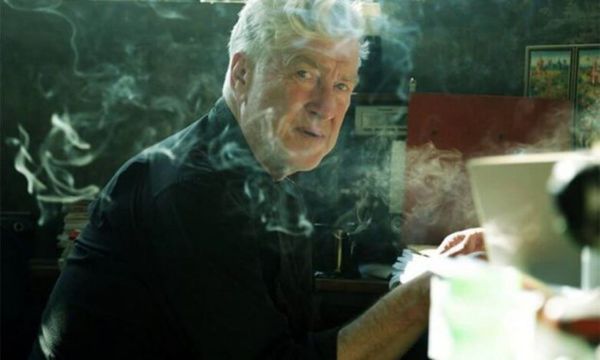 |
| Jon Nguyen on David Lynch: "Eraserhead, he says, is his Philadelphia story." |
David Lynch and Mark Frost's Twin Peaks is back with Sheryl Lee, Kyle MacLachlan, Sherilyn Fenn, Mädchen Amick, Peggy Lipton, Kimmy Robertson, Grace Zabriskie, Russ Tamblyn, Ray Wise, Everett McGill, Harry Goaz, Catherine E Coulson, James Marshall, and upcoming guest appearances by Laura Dern, Naomi Watts, David Duchovny, Julee Cruise, Balthazar Getty, Jennifer Jason Leigh, Michael Cera, Monica Bellucci, Richard Chamberlain, Amanda Seyfried, Jim Belushi and Eddie Vedder.
Splitting Naomi Watts in two, a Bob Dylan memory, understanding Mulholland Drive, the air in Eraserhead, the lines of Lost Highway, Oscar Kokoschka and how David Lynch: The Art Life all came together for Jon Nguyen, Rick Barnes and Olivia Neergaard-Holm are unearthed.
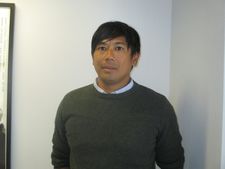 |
| Jon Nguyen: "Of course, the woman is the Blue Velvet scene." Photo: Anne-Katrin Titze |
Do you remember the name of the neighbour's child you used to play with in mud puddles? David Lynch does, and he recounts sitting in a hole under a tree with "little Dickie Smith", in Sandpoint, Idaho. His mother provided the water and we can surmise, the artist was born. "It was great fun," he says, off camera. We see present-day Lynch making tactile artworks in his fabulous studio in the Hollywood Hills with the Pacific light coming in.
Lynch's account of his memories end when his career as one of the world's greatest directors begins - with Eraserhead. We get to watch Lynch work on a sculpture, sit and smoke, or interact with his toddler daughter Lula in the present. Family photos and home movies light up the past. His mother refused to give little David coloring books, so as to not restrict his creativity. "She was warm but not demonstrative," he describes her.
Anne-Katrin Titze: Certain things are amazing. Sitting in a mud puddle with little Dickie Smith. I like how he [David Lynch] gives the full names of the people, the neighbours, who were important to him as a little child. It's funny, because we all remember those early names of people that long since have left our lives.
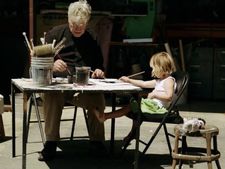 |
| David Lynch with Lula in his Hollywood Hills studio |
Jon Nguyen: I love that scene. That's his earliest memory, feeling this mud in his hands. And how today at 71 years old, he is still taken to this.
AKT: And you see him sculpting with his hands the muddy growth that oozes out of one of his paintings.
JN: David as a person helped me understand his films better. When he talks about how he likes to keep his art life separate and his family life separate and his friends separate - he didn't like anything mixing, it makes me understand why in Mulholland Drive the characters…
Suddenly Naomi Watts becomes a different character. And then all of a sudden she becomes another character. That's why his films have the structure they have because he kept everything separated.
AKT: "I always kept things very separate," he says.
JN: The characters in his films - they become totally separate. Nobody does that. To turn a character into a completely different character, keep them separate from the same character.
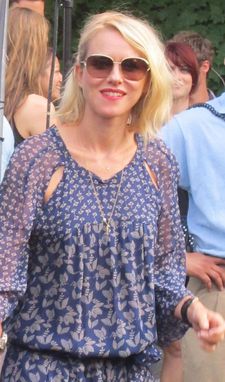 |
| "It makes me understand why in Mulholland Drive … Suddenly Naomi Watts becomes a different character." Photo: Anne-Katrin Titze |
AKT: Another point that is brought up is fear. About his first California sunset Lynch says "It was pulling fear out of me." The light - and cinema is light - can pull fear out of you. That's so true.
JN: He also says Philadelphia was his biggest influence. That's why his films sometimes have this really scary texture, scary mood. He gets that from his experience in Philadelphia. That's the juxtaposition and why his films are unique. The happiness and the dark.
AKT: And they are separate - that's the structure. These are the two quotes I have about fear. Right after he talks about the "chicken woman" he says, "there was thick, thick fear in the air." Again, it's the air, the light.
JN: Just like the air in Eraserhead. Eraserhead, he says, is his Philadelphia story. With what I learned about his life, finally I'm like, oh I understand his films better.
AKT: Are there specific moments?
JN: Of course, the woman [naked on the street] is the Blue Velvet scene. Another scene when he got stoned and he saw the lines on the road - the opening of Lost Highway! Maybe the time when he saw Bob Dylan as really little - it reminded me of that scene in Mulholland Drive when the old couple come out of the bag.
So these little things, he gets those from his own personal experiences. He had experiences and then projects them onto the film.
AKT: The relationship to his father, when he describes him walking to work in his cowboy hat - he comes to the conclusion how something that seemed so "uncool" can become "supercool" in retrospect. There's a separation again within the same person.
JN: And then the cowboy hat reminds me of Billy, The Cowboy [Monty Montgomery], from Mulholland Drive.
 |
| "Maybe the time when he saw Bob Dylan as really little - it reminded me of that scene in Mulholland Drive when the old couple come out of the bag." |
AKT: How long were the gaps in-between the interviews?
JN: Sometimes months but we were there the whole time. Two and a half years we were there waiting.
AKT: Whenever he says "Now?"
JN: We were in the compound because you don't know when he's going to be ready. A lot of times he is not in the mood to talk.
AKT: By 'in the compound' you mean you were living there?
JN: Living there. Two and a half years. I wasn't living there but the cinematographer [Jason S] was living there. Because David Lynch is not somebody where you say, okay, on Monday, 11 o'clock I come up and interview you. That doesn't work that way.
We had to be there and on the weekends and generally. I don't know what inspired him but on certain days he was just like "I want to talk". And then weeks would go by and he'd be busy.
AKT: When did you stop filming?
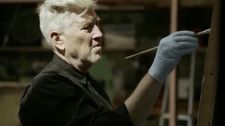 |
| "That's his earliest memory, feeling this mud in his hands. And how today at 71 years old, he is still taken to this." |
JN: We stopped about two years ago. The time when we weren't busy interviewing him, which is only 25 hours, the rest of the time we were sitting in a room logging, taking pictures of his paintings, of his photographs, organising. He had stacks of photo albums - we didn't know who is in it. We were kind of archiving everything.
AKT: He recounts this almost perfect family life.
JN: That's why he is such a nice person. Because he had a very nice family. He's a very nice person. He's kind of down-to-earth.
AKT: He describes his father going grocery shopping in a supermarket with him in Boston and then he didn't leave his apartment for a long time - a very nice juxtaposition between the ordinary and the extraordinary. "You sometimes have to make big mistakes and a big mess before you find what you're looking for" he says. Any big mess you made in the making of this film?
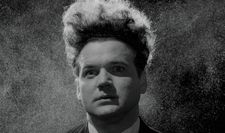 |
| "Just like the air in Eraserhead." |
JN: Lots of them! The film went through many, many revisions. Interviewing other people, putting in animation, or putting in archival that didn't belong to David. Calling up a library - "I need Boise from the Fifties." It doesn't really match up, it doesn't feel right.
AKT: Probably also giving other background, on Oscar Kokoschka, for example? You stayed away from all that?
JN: We've tried it. I've had pictures of Oscar Kokoschka. We've had texts describing what Philadelphia was like. None of it worked. After a lot of mistakes we finally got to the point. It works best to be pure with David.
AKT: Yes it does!
You can focus on Lynch's great hair or his relationship to people, whom he preferred to keep separate. "There's always a nervousness going out," he says and tells the story of how he left a Bob Dylan concert once, causing a big fight with another roommate who disapproved of anyone leaving a Dylan performance. You relate, or you don't. If you do, a glimpse into a new corner of the cave opens up.
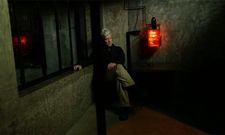 |
| "We were in the compound because you don't know when he's going to be ready. A lot of times he is not in the mood to talk." |
Read what Jon Nguyen had to say on connecting a Mr Smith in Boise, Idaho, to Winkie's diner, David Lynch's daughters Lula (Laura Dern's name in Wild At Heart) and Jennifer (voice in The Alphabet, starring Peggy Lynch) as bookends, and using "two layers to get more compact, more out of a scene" in David Lynch: The Art Life.
David Lynch: The Art Life is in cinemas in the US and will open in the UK on June 9.





















